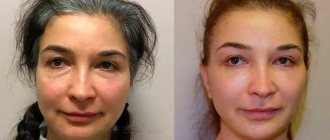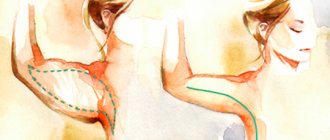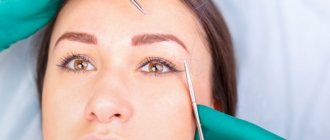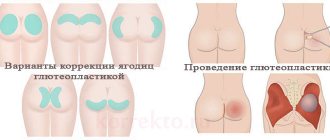Endoscopic facelift
Endoscopic lifting (facelift) is a type of plastic surgery. A characteristic feature is low trauma. Instead of a wide incision, several small ones are made, through which the surgeon redistributes the soft tissues of the face, tightening the skin. And to increase the accuracy of manipulations, an endoscope is used - a special device equipped with a camera.
Due to the absence of visible scars, endoscopic lifting is called “seamless lifting”
Another feature is that all the incisions are located in the scalp or in the mouth. That is, after healing they are not visible at all. In addition, the skin is not excised, as is customary in a circular lift, so there is no strong tension. The result is natural, and recovery does not take much time. And positive changes last from 3 to 10 years.
The method does not allow skin peeling; the surgeon works directly with the facial muscles. All actions are controlled using video transmitted by an endoscope.
There are several types of facelift:
- forehead and eyebrow lift;
- correction of the middle zone;
- lifting the lower third of the face.
But it should be noted that expensive equipment and highly qualified surgeons have a corresponding price. Depending on the amount of work and the prestige of the clinic, the cost of the operation varies greatly - from 75 to 400 thousand rubles. As a rule, the price includes consultation, examination, endoscopic lifting and hospital services.
Indications
Facelift is used to tighten the face. It allows you to adjust:
- asymmetry or lack of clear features;
- nasolabial folds;
- severity of wrinkles;
- bags under the eyes;
- drooping eyelids;
- drooping corners of the lips and eyebrows;
- sagging soft tissues and skin (weak or moderate ptosis);
- chin and neck area;
- "sad", "tired" or "gloomy" face.
Endoscopic lifting “lifts” facial features, visually refreshing the appearance
Preparation for endoscopic lifting
You should start by finding a clinic and a specialist. The surgeon's experience is a decisive factor. Up to 70% of the success of the operation depends on it, so take the time to study reviews, thematic forums and “after” photos. In this case, preference should be given to word of mouth, since most portals prefer to publish positive information with custom reviews.
Hair coloring and weight loss should be done before endoscopic lifting.
During critical days, endoscopic lifting cannot be done - the operation is prescribed at the end or beginning of the cycle
This is followed by a personal consultation with the surgeon, during which the presence of indications and contraindications is clarified. The doctor evaluates not only the appearance and desires, but also the health status of the potential patient. The following tests are required:
- Rh factor and blood group;
- general urine analysis;
- electrocardiography;
- coagulogram;
- radiography (fluorography) of internal organs;
- general and biochemical blood tests.
Based on them, the therapist makes a conclusion about the safety of general anesthesia and the possibility of surgery. In order for endoscopic lifting to proceed without problems, 10 days before surgery it is necessary to exclude:
- blood thinners;
- alcohol and cigarettes.
Operation duration
The preparation time is from 20 to 40 minutes, during which the patient is prepared for anesthesia and the upcoming operation. The endoscopic lifting process itself takes on average from 1 to 4 hours.
Day of surgery.
June 29, 2020.
I arrived at the clinic on time, without any incidents. They took me to the room and gave me a robe, slippers, a cap and panties) I changed my clothes. A clinic employee brought documents for signature and took my passport to issue my card. After completing all the paperwork, I took payment for the operation. Copies of documents were given to me. More details
1
HOW DOES REHABILITATION GO AFTER A FOREHEAD AND EYEBROW LIFT?
Patient stories:
| Olga | A year has passed since my surgery and I can say that I am definitely satisfied with the result. The forehead is moderately tucked, moderately mobile. |
| The result of my operation exceeded even my wildest expectations. I am delighted!!! I'm in seventh heaven with the result!!! And most importantly, I AM HAPPY!!! |
Endoscopic lift technique
The lifting technique seems simple, but in fact requires high-quality equipment and a good surgeon:
- The patient is put under general anesthesia.
- The skin is cut in 3–5 places. The incisions should be small and unnoticeable - usually 1-3 cm, but sometimes you come across “generous” specialists.
- An endoscope with a light bulb is placed into one of these incisions. The device displays an enlarged image on the monitor.
- All manipulations are performed through the remaining free incisions. Using special instruments, the surgeon moves and straightens the muscle tissue.
- At the end of the operation, the new “position” is fixed using special means: plates, sutures, fibrous glue, metal staples or bolts.
Do not confuse endoscopic lifting with SMAS and its modification - S lifting. The latter refers to traditional types of plastic surgery, which involve stretching and removing excess skin at the incision site. In addition, in cosmetology there is a SMAS procedure that is not associated with surgery - it uses ultrasound technology for rejuvenation.
Endoscopic forehead and eyebrow lift
Forehead correction helps smooth out wrinkles and improves the appearance of the eye area. But more often it is used because of the opportunity to remove the “sad” and “angry” look. 3-4 cuts are enough for the job. The surgeon carefully separates the muscles from the bones, lifting them up to the hairline and distributing them as needed. The new position is fixed using fibrous glue, staples or screws.
Sometimes a brow lift completely removes the drooping eyelid, which eliminates blepharoplasty
Endoscopic midzone lifting
A 2/3 face lift (mask lift) includes correction of the cheeks, cheekbones and nasolabial furrow, supplemented by blepharoplasty - removal of drooping eyelids and bags under the eyes. For lifting, biocompatible plates are used that reliably fix the cheek-zygomatic area in the desired area.
In addition to rejuvenation, mid-zone facelift is used for beauty – giving the face beautiful contours
Principle and general sequence of actions:
- First, the surgeon performs blepharoplasty. Excess skin is removed from the upper and/or lower eyelids, and the fat “hernia” can be eliminated. All incisions are made along the eyelash edge (crease) so that they are not visible in the future.
- 3 incisions are made “in the hair”, through which the cheekbones are corrected. And to change the area of the nasolabial folds and cheekbones, 2 additional incisions are used in the mouth, between the cheek and gum.
- Excess fat tissue is removed, while muscle tissue is redistributed and fixed, forming a new relief.
Endoscopic lift of the lower third of the face
Facelift of the lower third using an endoscope allows you to return clear outlines to the chin and jaw lines. In addition, proper redistribution of soft tissues makes it possible to delay the appearance of jowls and also smoothes out fine wrinkles.
Correction of the lower third of the face forms the so-called angle of youth - a beautiful transition from the chin to the neck
In this case, incisions are made near the ears and under the chin, and the tissue is lifted and fixed to the periosteum of the cheekbones. True, the effectiveness of such an effect is lower compared to other rejuvenation methods, so the operation is often combined with a neck (chin) lift and liposuction.
Possibilities of endoscopic lifting
Plastic surgery using an endoscope allows you to literally lift your face. Heaviness, fatigue and hagginess disappear, “floating” features become more refined and are emphasized favorably. This is what visually rejuvenates you by 5–10 years.
In addition, endoscopic lifting can correct:
- eye shape;
- oval and facial features;
- shape (curve) of eyebrows;
- nasolacrimal groove.
Endoscopic 2/3 face lift eliminates defects under the eyes, lifts the cheeks and eliminates nasolabial folds
The first positive changes on the face appear closer to the 2nd week of rehabilitation. And after a couple of months they are visible especially clearly, although the final result can be judged no earlier than six months later.
Video: endoscopic facelift (18+)
Rehabilitation period
The patient stays in the clinic from 1 to 3 days, depending on the type of endoscopic lift. And if everything goes well, he is discharged, having previously discussed the nuances of home care. So, you can wash your hair only on the 6th–14th day - first the surgeon must remove the stitches. Until this time, it is recommended to refrain from combing and decorative cosmetics.
You can return to a relatively normal life in 1–2 weeks. Although full recovery will take up to 2 months, during which you should avoid:
- physical activity, including active cleaning, bending and lifting heavy objects;
- swimming pools, baths, saunas and open reservoirs;
- sudden changes in temperature;
- solarium and sunbathing;
- using a hair dryer.
Never ignore medications prescribed by your doctor. But it is better to temporarily stop drinking soda, alcoholic beverages and coffee. Smoking, in turn, should be kept to a minimum.
To consolidate the result and reduce the likelihood of complications in the first days, it is advisable to wear a special bandage
For the first 2–8 days, it is advisable to monitor your facial expressions; try not to grimace too much. If you have cuts in your mouth, you should chew food carefully—preference is given to soups and soft foods.
Facial care after the procedure includes:
- Disinfection. Until the stitches are removed and the wounds heal, wipe the incision sites with an antiseptic twice a day.
- Fixation. Wear a compression bandage at least temporarily for a week.
- Hygiene. For 14–30 days, refrain from using scrubs and peels, use only mild cleansers.
- Proper sleep. During rehabilitation, it is advisable to purchase a high pillow and sleep on your back.
- Fighting swelling and bruising. Before using any creams or ointments, consult your doctor. Cold compresses can be applied to the face to reduce swelling.
To speed up the healing process, surgeons refer the patient to a cosmetologist. An individual set of procedures is prescribed with an emphasis on lymphatic drainage and normalization of blood supply. Microcurrents are often used as basic therapy - exposure to a weak pulsed current stimulates cell regeneration.
Contraindications and possible consequences
Endoscopic facelift is not performed if:
- age less than 25 and more than 50 years;
- damage to the skin (wounds, inflamed acne, fresh tan, etc.);
- anemia, poor clotting;
- predisposition to the formation of keloid scars;
- pregnancy or breastfeeding period;
- cardiovascular and endocrine diseases, including diabetes;
- disorders of the thyroid gland (other internal organs);
- oncological problems - benign and malignant neoplasms;
- infectious and dermatological diseases, including chronic and acute;
- respiratory failure, asthma;
- nervous and mental disorders;
- menses.
The surgeon may refuse a patient with a high and/or prominent forehead. This feature often complicates the operation. It is not recommended to do a facelift on a full face (if you are overweight), as well as on people with large cheeks - the result will be less pronounced and is unlikely to last the promised 5 years.
Pay attention to old scars, acne marks or pigmentation. If there are any, then there is a possibility that they will stretch unsightly across the face after the facelift.
Endoscopic lifting is not without bruising, so it will definitely aggravate the manifestation of rosacea
Ignoring contraindications leads to both prolonged rehabilitation and serious complications. But the latter can also be the result of poor-quality surgery, non-compliance with the surgeon’s recommendations, or even an individual reaction of the body. Possible side effects:
- Hematomas. They occur in almost everyone and go away within 2–4 weeks. This is a normal phenomenon - when tissues are displaced (elevated), injury to blood vessels cannot be avoided.
- Increased swelling. Another phenomenon caused by surgery. It lasts from a week to several months. May cause temporary non-closure of the eyelids.
- Redness and pain in the operated areas. Unpleasant sensations can occur due to swelling, infection, doctor error or body characteristics. Painkillers are allowed during the recovery period, but consult a specialist.
- Infected inflammation. You can catch the “sore” on the operating table or during the recovery period; it is enough to neglect basic hygiene rules. Treatment is selected by a surgeon or attending physician.
- Slow healing. Individually, although smokers often face this problem. To speed up your recovery, try to follow your doctor's advice.
- Asymmetry. It does not occur so often; it appears due to an uneven fat layer or improper fixation. In rare cases, it is caused by damage to the facial nerves, which may be accompanied by disturbances in facial expressions and partial or complete loss of sensation. Treatment is selected depending on the nature of the damage, and recovery takes about a year.
- Local baldness. It is possible in cases where scars form at the site of the sutures. Unfortunately, it is impossible to completely restore hair growth in these areas. But removing scar tissue and microcurrents can reduce the scale of the problem and make it less pronounced.
- Numbness. If it is not associated with injury to the facial nerves, then the cause lies in swelling and tissue displacement. Typically, sensitivity returns within 6–12 months.
- Severe sagging of the face. This happens extremely rarely and is only due to the fault of the surgeon. To fix it, a repeat facelift will be required.
A surgical facelift can be performed at any time of the year. But if you want to avoid all possible difficulties during rehabilitation, it is better not to undergo surgery in the midst of a hot summer. Especially in the case when you simply do not have the opportunity to sit at home until you fully recover.
Video: complications after endoscopic lift
Table: pros and cons of endoscopic lift
| Advantages | Flaws |
|
|
Safety measures during the operation
The most important stage is the preliminary examination. A consultation with a surgeon will help determine the feasibility of an endoscopic lift, but this does not replace the need for tests. And in this regard, it is better not to fuss - a thorough check will ensure safety during the operation.
Endoscopic lifting is almost always performed under general anesthesia. The last meal before surgery should be no later than 18:00–20:00 (at least 6 hours before surgery). This time may vary; exact recommendations are clarified by the surgeon or anesthesiologist.
Surgical procedures to correct appearance are not mandatory or important, so you should be thoroughly prepared for them
Combination with other methods of rejuvenation
To get the maximum effect, endoscopic lifting is supplemented with:
- liposuction - removal of adipose tissue;
- rhinoplasty - nose correction;
- blepharoplasty - eyelid correction;
- platysmoplasty - correction of the chin and neck area.
In controversial situations, it can be combined with a traditional circular lift. This is relevant when it is too early for radical measures, but in some places there is already excess skin. This approach also helps reduce the trauma of plastic surgery.
To eliminate facial wrinkles, forehead and eyebrow lifting is combined with Botox injections. And if you need to increase skin elasticity, rehabilitation is supplemented with biorevitalization, massage and mesotherapy.
Correction of individual areas of the face does not have strict age restrictions
TOP-lifting is the optimal method for lifting the forehead and eyebrows
In most cases, to solve the problem of lifting the eyebrows and forehead, light correction and rejuvenation of the upper eyelid, Dr. Bely uses an improved TOP-lifting technique. The operation is performed through two shortened (about 2.5–3 cm) incisions located in the outer corners of the forehead along the hairline. This mini-surgery is less traumatic compared to both coronary and endoscopic forehead lift. The total length of the incision is almost the same as that of an endoscopic lift, but there is no detachment of the scalp, the hairline is not affected (and can even be improved if required). Rehabilitation is also shortened – 1–2 weeks.










